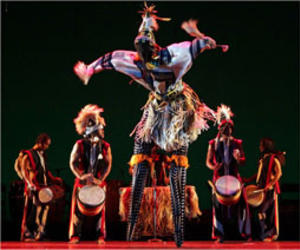The Dances of Africa, as Filtered Through the Americas
- Submitted by: manso
- Editorial Articles
- 05 / 31 / 2011

By GIA KOURLAS.May 29, 2011. There’s nothing like a DanceAfrica performance to send you straight to summer. It has its own flow, and you can’t fight it, no matter how chaotic, raucous and hazily dull it becomes. Chuck Davis, the group’s artistic director, loves to speechify, and during the nearly two-and-a-half hour program at the Brooklyn Academy of Music on Friday night — it was so long he had to cut the finale — there were two award presentations and a memorial service to honor those once connected to DanceAfrica.
This Image by Andrea Mohin/The New York Times
DanceAfrica 2011, at the Brooklyn Academy of Music, includes the Bambara Drum and Dance Ensemble, here performing “Journey.” On stilts: Vado Diamonde.
In other words, there’s more to DanceAfrica, or African dance, than a pair of undulating hips; embracing the ancestors and feeling the love in the room are part of the package.
DanceAfrica is now in its 34th season, and DanceAfrica 2011 pays homage to “Expressions and Encounters: African, Cuban and American Rhythms” with performances by the stellar Cuban company Ballet Folklórico Cutumba as well as the young, local BAM/Restoration DanceAfrica Ensemble. Peggy Alston, the director of the Restoration’s Youth Arts Academy, was honored Friday.
Cutumba, based in Santiago de Cuba, was formed in 1960. In “Orisha” the dances focused on the deities of Yoruban spirituality; Laima Martinez Coello gave the most electrifying performance in a sky-blue dress. While never losing the curve of her torso, she gathered the folds of her skirt — with its hidden layers of white-trimmed ruffles — and spun, transforming her body into an ocean wave.
In “Palo,” or “Stick” in Spanish, Kùlú Mèlé African Dance & Drum Ensemble of Philadelphia offered a dynamic work exploring the use of sticks in the preparation of altars to honor the spirits of ancestors. The women, in white and red or blue, moved in deliberate unison, as did the bare-chested men, who used their arms to push forward and contract back, sending their bodies into ripples of motion.
Bambara Drum and Dance Ensemble, from the Bronx, offered “Journey,” which erupted into a swirl of color and movement as drummers created a wall of percussive sound. Vado Diamonde, a stilt walker, managed high kicks, as well as a back walkover in thrilling and suspenseful slow motion. Richard Nixon, just a dancer on his own two feet, showed articulation in his fleet footwork, and Michele Stafford and others knew a thing or two about how to whip their hair back and forth.
The dance portion of the program ended with Cutumba’s “Tumba Francesa,” choreographed by Roberto David Linares and directed by Nieves de Armas. Based on a slaves’ parody of ballroom dance, the 1970 work brought the return of Ms. Coello — with total elegance she bent all the way back to pick up a handkerchief on the floor with her teeth — and Juan Carlos Cabrera, who turned the lower half of his body into something like silk. His fluent, slippery feet buckled but never lost their grip.
But nothing was as magnificent as when the performers gracefully wove pieces of fabric around a maypole and then unraveled them. Darting, ducking and leaping, they seemed to be flying — an extraordinary physical feat and choreographed to perfection.
DanceAfrica 2011 continues through Monday at the Brooklyn Academy of Music, 30 Lafayette Avenue, Fort Greene
Source: www.nytimes.com/2011/05/30/arts/dance/danceafrica-at-brooklyn-academy-of...
Comments